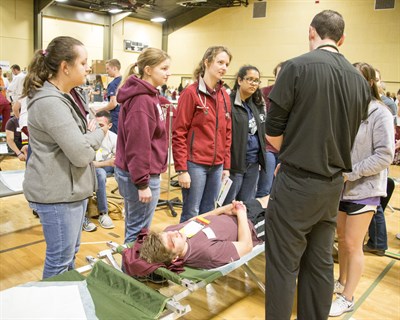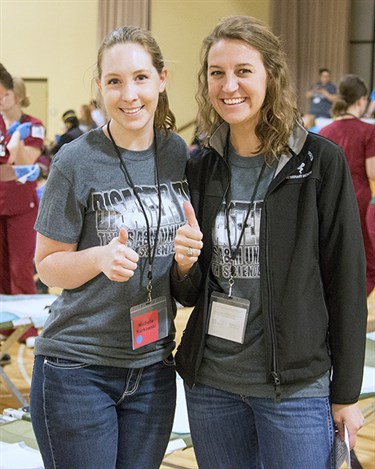CVM Students Put ‘One Health’ Into Practice During Disaster Day
The gymnasium of the Central Baptist Church Family Life Center in Bryan is filled with more cots than the eye can absorb in a single glance. People wander aimlessly through the room, past emergency stations set up for triage or to dispense medicine, as students meet and attend to the needs of the injured or ill.
Screams randomly echo off the walls as a young man lies on one of those cots while Texas A&M students hover over him, assessing the dog bites on his leg and face. Another young man walks past, searching for his dog. Has anyone seen his dog?
It sounds like the scene from a pandemic genre movie, but it’s actually all a part of the ninth annual Disaster Day training hosted in March by the Texas A&M College of Nursing. The largest student-run mass casualty simulation event in the country brought together more than 300 students from nursing, pharmacy, medical, and, for the first time, from the College of Veterinary Medicine & Biomedical Sciences (CVM), all of whom were employed to act as care providers for more than 400 volunteers portraying victims of a hurricane.

Students were able to gain experience by putting into practice the knowledge and skills they are acquiring within all of Texas A&M’s medical disciplines. While nursing and medical students assisted actors with “broken bones” or “flesh wounds,” 30 veterinary students reacted to three vet-med scenarios written by Michelle Kurkowski and Laura Hurst, third-year veterinary students and co-presidents of the Student One Health Association.
Kurkowski and Hurst, who were instrumental in the CVM’s involvement in Disaster Day and served as the vet-med liaisons during the event, specifically created the cases with input from students from the other colleges in an effort to incorporate both human and animal medicine.
The scenarios were designed to create a realistic experience that students might encounter in a similar situation as professionals; they included a man and his dogs showing signs of a bacterial disease and a girl suffering from head trauma who was brought in with her dog; it was ultimately discovered that the girl was epileptic and the animal was her service dog.
“The vet students and the medical/nursing students had to realize that the dog and the girl needed to be kept together at all costs,” Kurkowski said. “Failure to recognize this would result in the girl seizing without warning.”
In another incident, a child was bitten by a husky amidst a dog fight.
“The owner took the dog to the tent for veterinary care and informed the students that the dog wasn’t current on its rabies vaccination. The bitten child was in the medical tent and it was the veterinary students’ job to find the attending physician and inform him that the dog wasn’t current on its vaccine,” Kurkowski said. “The mother of the child demanded the dog be euthanized, and the medical and veterinary students had to diffuse the situation.”
The best part of practicing in this simulated environment, according to Kurkowski, was the collaboration that emerged between the veterinary, medical, and nursing students.
“The veterinary students greatly enjoyed the chance to interact with the other colleges and get in on the main action. They also remarked that they learned a lot clinically,” she said. “The senior students were vital in helping to teach the younger students how to approach each clinical case and make decisions.
“The medical and nursing students began to seek out the veterinary teams for assistance when needed; they even began to consult with the veterinary teams on cases that were not originally written as med-vet interface cases,” Kurkowski said. “The students seemed to enjoy the additional layer of complexity to the scenario once it was clear what was expected of them and how to respond to veterinary situations. The veterinary students were able to teach new things to the human medical providers and vice versa.”

Likewise, students learned a lot from what went wrong during the day; because this was the first year that veterinary cases were incorporated into Disaster Day, awareness and communication were two hurdles that had to be overcome early.
“These experiential training opportunities in which our Texas A&M students participate help them think outside the box; work with interdisciplinary teams of medical, nursing, pharmacy, and veterinary professionals; and successfully address disasters,” said Rosina (Tammi) Krecek, research professor for Texas A&M’s Global One Health initiative. “Such training builds confidence and readiness in our students to face inevitable challenges such as natural disasters, pandemics, and other catastrophes.”
In addition, members of Texas A&M’s Veterinary Emergency Team (VET)-the largest and most sophisticated veterinary medical disaster response team in the country- set up tents outside to support the cause, helping students understand what it’s like to deploy for a disaster on the veterinary side by working through animal cases.
“It’s not just taking care of animals when you’re in a disaster environment; there’s noise and chaos around you, people constantly coming in with this or that problem or needing you to talk to the media or offering to volunteer,” said Deb Zoran, professor in the Department of Small Animal Clinical Sciences and VET member. “The chaos of a disaster environment is similar to all of the other things that are going on while you’re just trying to be a veterinarian; that’s a really good skill set to learn for life.”
While these devastating events are hard to mimic through simulation-in Brazoria County, for example, the VET saw more than 350 companion animals over a 10-day period, accounting for about 30–35 animals a day coming in suddenly and sporadically-Zoran said there’s no question that the activity was valuable for students.
“It is a great experience that allows the fourth-year veterinary students opportunities to practice being team leaders. Perhaps most importantly for the first-, second-, and third-year veterinary students, it is the first time they’re introduced to disaster response and the concept of triage and stabilization,” Zoran said. “This training will help them as they continue in school because it’s just another way of developing the skills of thinking things through and problem solving.”
Kurkowski and Hurst also tied in an educational component following the simulation by providing handouts and bringing in CPR dummies to teach participants about canine CPR; they hope to establish an even greater presence at Disaster Day next year to increase the learning opportunities for everyone.
“There is never a large-scale disaster, natural or man-made, that doesn’t involve animals in some way; people are very attached to their animals and often consider them members of the family, and anyone who works in disaster management needs to understand this and have a plan for how to handle it,” Kurkowski said.
“That’s why it was so important for us to participate in Disaster Day; we wanted to add another layer of reality to the incredible learning experience that the School of Nursing has created,” she said. “We also wanted to show students from all of the schools the communication and collaboration that is necessary when animals are inevitably involved, so that they are better prepared for the real deal.”


